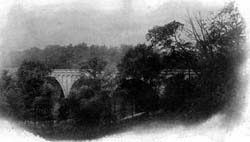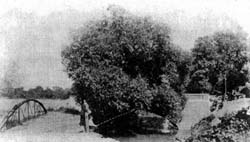|
Bridges of Cleveland and Cuyahoga County, 1918 AN EARLY CLEVELANDER'S VISION WHICH CAME TRUE By W. A. Stinchcomb Way back in 1835, an editorial appeared in a Cleveland newspaper drawing attention to the necessity of better communication between the east and west sides of Cleveland. In prophetic terms, the writer conceived the idea of constructing a great highway across the Cuyahoga Valley. In connection with the building of a big high level bridge, he submitted the idea of even having tenements constructed in connection with it, which would face on the roadway thus created. The dreamer, whose vision in part came true, was Oliver P. Baldwin, city clerk in 1836, who wrote the editorial in The Cleveland Daily Advertiser, just about the time he retired. It was as follows: A PROJECT "On visiting Cleveland and Brooklyn a few days since, and surveying the disadvantages which exist in a communication between those two cities, I was naturally led to reflect what great plan could be adopted which the prospects of the place and the condition of the country would warrant to remove all those difficulties, produce harmony between the two and do immortal honor to the whole state, as well as confer a great facility and benefit on every traveler and every inhabitant of our common country. "That there is an immense amount of travel along the lake, and that that travel is constantly increasing, and will continue to increase, is quite certain; and that some great facilities for traveling on the southern shore of Lake Erie are imperatively called for, is equally certain. The Ohio Railroad, if built and extended to Buffalo with double track, would, in my opinion, answer this object; and that such a road will be built no person can for one moment doubt. This assurance arises from the fact that it lies in the most natural direction, and almost the only passable route for such a work from the Eastern States to the great and growing West. And it is not a matter of doubt that the Cleveland and Cincinnati Railroad will be built to open a direct communication to that and by another railroad to Charleston, S.C., both of which great thoroughfares must cross the Cuyahoga River
at or near Cleveland and Brooklyn; and under all these circumstances, together with the local advantages of these points, who can doubt that Cleveland and Ohio City are destined soon to become two great populous, commercial and worthy cities? "That some communication between these two rival cities of tenfold greater magnitude and convenience than any or all that has been enjoyed, is absolutely necessary, needs no proof. "The following project is therefore laid before your readers and the whole community. It is to be built by a company chartered for the purpose, or by the State, a grand and stupendous bridge from the top of the hill in Cleveland to the top of the hill in Ohio City, from suitable points in each place, and that it be built of stone with a sufficient number of arches of WASHINGTON PARK CONCRETE BRIDGE the best mason work, supported by stone piers laid deep and strong, either solid or arched width-ways, and that this bridge be 120 feet wide, all of the best stone work, and level on the top for the above railroads, and a common road with sidewalks and iron railings, and that walls of brick or stone be carried up on each side of the bride with a center or partition wall in the middle, and other partition walls the other way as often as necessary. And that floors be placed in all these apartments as many stories as the whole height of the bridge would allow, and that those rooms on each side, sixty feet deep, and such width as would be convenient, would form the best, most convenient and permanent stores and warehouses that could be conceived of, and the most secure from fire or any other disaster.
"The upper stories might be occupied a shops, offices, or even boarding houses, and every apartment made accessible by flights of stairs as well from the top of the bridge as from the ground. This bridge would be high enough to allow any masts or rigging of any vessel that sails the lake to go clear under, so that it would not impede the navigation of the river, and these stores, warehouses, rooms and tenements would rent for a sum sufficient, with what two great railroad companies can well afford to pay, to refund the whole expense of the work in ten years from its completion. "The street crossing under the bridge would occupy no more room than was necessary for passing conveniently; and even here stores might front on these sheltered streets 120 feet on each side. "I have not attempted to give a minute description of the work, nor suggested one-half of the advantages, but have simply laid the subject before my fellow citizens in a plain unvarnished way, and I will only add that such a work is of great importance and absolutely necessary, and would advance the growth, wealth and prosperity of Cleveland and Ohio more than any work of the same magnitude that can be conceived -- would afford the public a convenience which would be of such universal utility and importance as would be surpassed by no other object than necessary food and clothing, and confer immortal honor on the State or the company that built it. One-half of the surplus revenue coming to this state would be sufficient to accomplish the work, and would be a very profitable investment -- greatly superior to the canal or any other work hitherto undertaken by the state or any chartered company in it; and it can, must and will be done." The suggestion was considered merely a wild fancy at the time, which was possible but not probable of execution. What would the author of the editorial think if he could come back today and witness the splendid accomplishments of modern engineering, practice, as exemplified in the new Detroit-Superior high level bridge! THE OLD AND NEW
|
||
| PREVIOUS CHAPTER | TABLE OF CONTENTS | |
|
||


